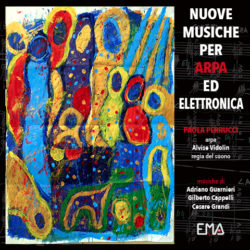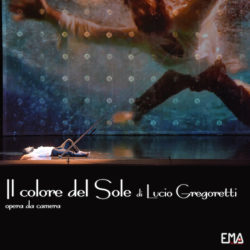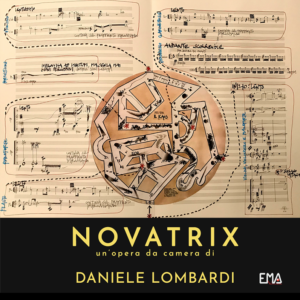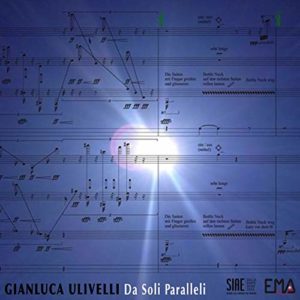Descrizione
- Davide Ianni | 1978 – [Ni] Svanito costrutto | 2014
- Giulia Monducci | 1981 – Shinryoku | 2021
- Mattia Clera | 1987 – La sola distanza | 2015, rev. 2019
- Lorenzo Troiani | 1989 – Cratere | 2013
- Federico Costanza | 1976 – La misteriosa voce di Skip James | 2021
Il Progetto
Il progetto ItalianElectricGuitar Project nasce dalla mia volontà di rinnovare e promuovere il repertorio solistico per chitarra elettrica, con l’intenzione di offrire un’attuale – seppur personale – panoramica della produzione per questo strumento di compositori italiani. Sempre di più, oggi, le identità compositive di carattere nazionale si fondono a differenti estetiche, diventando – così – sia individuali e personali che appartenenti a pensieri, eterogenei, poliedrici e – inevitabilmente – internazionali. È il caso, appunto di questo progetto, con cui si vuole dar voce a queste individualità attraverso un contenitore e filtro di idee in continua ricerca.
Seppur IEG Project contenga lavori di compositori italiani, il titolo in lingua inglese volge uno sguardo poetico internazionale, poiché gli autori proposti in questo lavoro fanno della multiculturalità e polivalenza di pensiero chiavi espressive delle proprie estetiche e cifre creative. Queste sono mobili, trasversali, intersecando generi ed epoche molteplici, che però trovano in questo progetto discografico un territorio comune.
In questa selezione di lavori, alcuni muovono da immaginari compositivi eredi di reminiscenze acustiche vicine anche alla tradizione non accademica di matrice rock. Altri, invece, si rivolgono a immaginari lontani dai riferimenti più idiomatici appartenenti allo strumento. IEG Project si costituisce, dunque, come un progetto in divenire. Il costante work-in-progress e la continua trasformazione di IEG Project vede oggi coinvolti sia compositori già affermati nel panorama europeo e internazionale che giovani autori.
Ambizione ulteriore che questo progetto desidera proporre esprime la volontà di delineare percorsi ‘altri’, con l’augurio di tracciare nuovi riferimenti in un repertorio ancora troppo rilegato a poche composizioni, seppur oggi emblematiche. IEG Project mira, dunque, alla creazione di un “cantiere aperto” capace di raccogliere e convogliare volontà e pensieri musicali odierni, filtrando esperienze e creatività poliedriche attraverso – anche – la commissione di nuovi lavori.
Carlo Siega
Le Composizioni
[Ni] Svanito costrutto |2014, per chitarra elettrica
[Ni] Svanito costrutto narra di una voce, che indaga sentieri lirici estesi, in continuo conflitto tra l’etereo e lo squarcio profondo. Un canto che nasce dal silenzio; evolve, si espande, esplode; un canto che muta e si racconta attraverso un percorso che tenta di delineare un sentiero sottile. Sono proprio i territori di limite – tra la costruzione di una trama e il suo svanire verso una nuova ripresa – che cadenzano il percorso di [Ni] Svanito costrutto. Qui, attraverso un uso molteplice e cangiante dell’e-bow e del bottleneck, si generano i canti. Attraverso risonanze naturali dello strumento e anche grazie all’intervento di episodi percussivi sul corpo, la monodia del primo canto si espande a polifonie fatte di armonici, campi acustici risuonanti che sussurrano e urlano, che si espandono e si contorcono. Poi svaniscono.
Shinryoku | 2021, per chitarra elettrica
Shinryoku si presenta come un breve evento aforismatico; uno scrigno che racchiude e concentra molteplici possibilità espressive attraverso gestualità strumentali idiomatiche dello strumento, quali tapping, legature (hammer-on, pull-offs), sweep-picking e armonici artificiali. Queste – affidate principalmente alla mano sinistra – sono tecniche che fungono da punto focale, come centro di interesse per generare mondi sonori in costante rapporto di omogeneità-eterogeneità, per essere – così – concentrati e intrecciati all’interno di un breve unicum senza soluzione di continuità.
(Giulia Monducci)
La sola distanza | 2015, rev. 2019, per chitarra elettrica
La distanza è ciò che collega i due luoghi da cui proviene il suono: il plettro e le dita. Essa spinge la dialettica del loro potenziale articolatorio sino al limite critico, dove le dita generano eventi ritmici senza l’uso del plettro e dove il plettro genera eventi ritmici senza l’uso delle dita. Questa distanza viene superata per riscoprire il punto esatto in cui il suono esiste contemporaneamente in questi due luoghi. Quando questi due elementi contribuiscono sincronicamente alla produzione dell’evento sonoro, la chitarra elettrica riappare con la sua storia. Riappare da luoghi molto lontani: da quei rumori ai margini dello strumento che anni di pratica mirano a nascondere (ma senza i quali non c’è nulla), cercando ora – in essi – fraseggi e figure, la canzone nella ‘non-canzone’.
(Mattia Clera)
Cratere | 2013, per chitarra elettrica
Cratere è lo sguardo da una crepa nel suolo, dal profondo, da un luogo appartato, quasi uterino. Le corde, come tendini, si allentano e si tendono, deformando il suono e facendo emergere la natura metallica delle corde attraverso un flusso continuo fatto di onde e strati (“gassosi”, “liquidi”, “solidi”). Per tutta la composizione assume una grande importanza la whammy bar che permette – appunto – la deformazione della corda e, quindi, del suono.
(Lorenzo Troiani)
La misteriosa voce di Skip James | 2021, per chitarra elettrica ‘backside’ & elettronica
La dedica nel titolo rappresenta un territorio di esplorazione e ricerca verso una trasfigurazione dei misteri energetici del suono propri della cultura blues, con uno sguardo alla figura del bluesman americano Skip James. La specificità dello strumento aumentato dato dall’unicità della chitarra elettrica di Siega, insieme all’uso dello strumento come ‘dispositivo’ mono-corda, tenta di produrre visioni e architetture di suono capaci di evocare una voce che si fa corpo attraverso quella ‘macchina’ che è il ‘performer+iper-mono-strumento+ ecosistema elettronico’. La scomposizione e l’organizzazione in vari livelli di ampie riverberazioni del suono, le varie pratiche dell’uso dello slide (oggetto magico nella musica blues), l’accordatura intesa come una sfocatura esplosiva di un singolo suono senza più confini, anelano a un tempo fermo capace di restituire uno spazio all’ascolto, anche in fase performativa. Un’idea dello spazio, anzi degli spazi, al plurale, propria della fisica: dagli estremi che si toccano dello spazio siderale e di quello della meditazione più interiore. Spazio pieno che contiene il vuoto e ne è contenuto. La misteriosa voce di Skip James è stata scritta per Carlo Siega e dedicata alla sua ricerca sul momento performativo.
(Federico Costanza)
The Project
ItalianElectricGuitar Project arises from my desire to renew and promote the solo repertoire for electric guitar, able to offer a current – although personal – overview of today’s production of this instrument by Italian composers. More and more today, compositional identities of a national character are merging with different aesthetics, becoming – thus – both individual and personal and belonging to heterogeneous, multifaceted and – inevitably – international thoughts. This is precisely the case with this project, which aims to give voice to these individualities through a container and filter of ideas in continuous research.
Even though IEG Project presents compositions by Italian composers, the English title addresses an international poetic gaze, since the authors proposed in this work make the keys to the expression of their own aesthetics and creative figures multiculturalism and polyvalence of thought. These are mobile, transversal, intersecting multiple genres and eras. However, all these features find a common territory in this recording project.
In this selection of works, some compositions move from imaginaries to acoustic reminiscences closer to the non-academic tradition, as blues and rock music. Others turn to imaginaries far removed from the more idiomatic references belonging to the instrument. Indeed, IEG Project is constituted as a project in the making. Its constant work-in-progress and continuous transformation now involves both composers already established on the European and international scene and young authors.
A further ambition that this proposal wishes to propose is the desire to outline a path of divergence, with the hope of tracing new references in a repertoire that is still too much relegated to a few compositions, although today become emblematic. For these reasons IEG Project aims to create an ‘open yard’ capable of gathering and conveying today’s musical wills and thoughts, filtering multifaceted experiences and creativity thinking, also through the commissioning of new works.
Carlo Siega
The Compositions
[Ni] Svanito costrutto |2014, for electric guitar
[Ni] Svanito costrutto tells of a voice. It investigates extended lyrical paths in continuous conflict between the ethereal and the profound. A song born from the silence; it evolves, expands, and explodes; a song that mutates and narrates itself through an itinerary that attempts to delineate a subtle path. It is precisely the borderline territories – between the construction of a plot and its fading towards a new resumption – that cadence the route of [Ni] Svanito costrutto. Here, the lyrical patterns are generated through multiple uses and changes techniques of the e-bow and the bottleneck. Through natural resonances of the instrument and percussive interventions on the body, even the monody of the ‘first song’ expands to polyphonies made of harmonics. These resonant acoustic fields whisper and shout, extend and twist. Then they vanish.
Shinryoku | 2021, for electric guitar
Shinryoku presents itself as a short aphoristic event. This is a casket that encloses and concentrates multiple expressive possibilities through idiomatic instrumental instrument gestures, such as tapping, legatos (hammer-on/ pull-off), sweep-picking and artificial harmonics. These – entrusted mainly to the left hand – are techniques which act as a focal point, as a centre of interest for generating sound worlds in a constant balance between homogeneity and heterogeneity, to be – therefore – concentrated and interwoven within a short seamless unicum.
La sola distanza | 2015, rev. 2019, for electric guitar
The distance is what connects the two places from which the sound appears: the plectrum and the fingers. It pushes the dialectic of their articulatory potential to the critical limit, where the fingers generate rhythmic events without the use of the plectrum, and where the plectrum generates complex figures without the use of the finger. This distance is overcome to rediscover the point where sound exists simultaneously in these two places. When these two synchronously contribute to the production of the sound event, the electric guitar then reappears with its history. And it reappears, from very distant places: from those noises on the edge of the instrument that years of practice aim to hide (but without which there is nothing), now seeking in them phrasings and figures, the song in the ‘non-song’.
Cratere | 2013, for electric guitar
Cratere is the gaze from a crack in the ground, deep within, and secluded, almost uterine place. The strings, like tendons, loosen and stretch, deforming the sound and bringing out the metallic nature of the string through a continuous flow of waves and layers (‘gaseous’, ‘liquid’, ‘solid’). Throughout the composition, the whammy bar takes on great importance, allowing – precisely – the deformation of the string and, therefore, the sound.
La misteriosa voce di Skip James | 2021, for ‘backside’ electric guitar & electronics
The dedication in the title represents a territory of the exploration and research towards transfigured energetic sound mysteries, and the characteristics of blues culture, looking at the figure of the American bluesman Skip James. The specificity of the augmented culture, looking at the figure of the American bluesman mysteries of the sound and the characteristics of blues instrument given by Siega’s unique electric guitar with the use of the instrument as a single-string ‘device’ attempts to produce visions and architectures of the sound able to evoke a voice, which becomes a body through that ‘machine’ represented by the ‘performer + hyper-mono-instrument + electronic ecosystem’. The organisation of sound and its decomposition into various levels of reverberations, multiple practices of the bottleneck (a magical object in blues music), the tuning assumed as an explosive blurring of a single sound with no boundaries, yearning for a time still capable of restoring a space of listening, even within the performative phase. An idea of space, or better, spaces – in its plural form – proper to physics: from the touching extremes of sidereal space and that of the most interior meditation. The whole space contains the void and is held by it. La misteriosa voce di Skip James is written for Carlo Siega and is dedicated to his research on the performative moment.
(Translations by Carlo Siega)
Carlo Siega | Chitarra elettrica
Vincitore del prestigioso Kranichsteiner Musikpreis per l’interpretazione ai Ferienkurse für die Neue Musik di Darmstadt, Carlo Siega è artista attivo in qualità di chitarrista, artista multimediale e ricercatore. È stato ospite di importanti rassegne nazionali e internazionali quali TransArt Festival, Festival Aperto di Reggio Emilia, Festival Traiettorie di Parma in Italia, a SMOG, Nuits de Beau Tas, Ear To the Ground Festival e Kunstenfestival des Arts in Belgio, Izlog Festival in Croazia, Impuls Festival e Neue Oper Wien in Austria, al Time for Music Festival in Finlandia, al Festival dei Ferienkurse für die Neue Musik in Germania, Warsaw Autumn in Polonia, al Festival Ensems, Mixtur Festival, VANG Festival, SIRGA Festival e l’Universidad de Léon in Spagna, SoundSpaces Festival in Svezia, per citarne alcuni.
Ha tenuto seminari e masterclass dedicati alla nuova musica, alla chitarra elettrica e alle pratiche di re-interpretazione della musica sperimentale storica in diverse istituzioni in Austria, Italia, Spagna, sviluppando progetti multidisciplinari e multimediali (artista residente al Music Center Bjiloke e Voruuit a Gent, Belgio).
In qualità di ricercatore e accademico, ha tenuto conferenze presso PARL_Next Generation (Linz), Chigiana Conference 2020, Method/Art Conference (Conservatorio Reale di Anversa), IRCAM Forum & Workshops (Parigi), ‘21st Century Guitar Conference’ (Lisbona), International Conference on New Music Concepts 2021 (Treviso), Orpheus Instituut (Gent), Convengo di Musicologia della SIdM, EPARM 2023 (Royal Danish Academy di Copenhagen).
Diplomatosi in chitarra in qualità di allievo privatista, Carlo ha proseguito gli studi presso il Conservatorio ‘B. Marcello’ di Venezia (Biennio di II Livello), l’IrMus della Scuola Civica di Musica ‘C. Abbado’ di Milano (chitarra elettrica), la ICTUS Academy a Bruxelles e il KASK di Gent in Belgio (MA of Arts in Contemporary Music) e il Conservatorio di Musica ‘G. Tartini’ di Trieste (Biennio di II Livello in Musica Elettronica e Composizione Multimediale).
Winner of the prestigious Kranichsteiner Musikpreis for interpretation at the Ferienkurse für die Neue Musik in Darmstadt, Carlo Siega is a guitarist, multimedia artist, and researcher. He has performed throughout Europe as a guest at major national and international festivals such as TransArt Festival, Festival Aperto in Reggio Emilia, Festival Traiettorie di Parma in Italy, at SMOG, Nuits de Beau Tas, Ear To The Ground Festival and Kunstenfestival des Arts in Belgium, at the Izlog Festival in Croatia, Impuls Festival and Neue Oper Wien in Austria, Time for Music Festival in Finland, Ferienkurse für die Neue Musik in Germany, Warsaw Autumn in Poland, Festival Ensems, Mixtur Festival, VANG Festival, SIRGA Festival, and Universidad de Léon in Spain, SoundSpaces Festival in Sweden, to name a few.
He has held seminars and masterclasses dedicated to new music, electric guitar and re-interpretation practices of historical experimental music in several institutions in Austria, Italy, and Spain, developing multidisciplinary and multimedia projects (artist in residence at Music Center Bjiloke and Voruuit in Gent, Belgium).
As a researcher and academic, he has given lectures in several institutions, as PARL_Next Generation (Linz), Chigiana Conference 2020, Method/Art Conference (Royal Conservatory of Antwerp), IRCAM Forum & Workshops (Paris), ’21st Century Guitar Conference’ (Lisbon), International Conference on New Music Concepts 2021 (Treviso), Orpheus Instituut (Ghent), SIdM Musicology Convention, EPARM 2023 (Royal Danish Academy in Copenhagen).
After graduating in guitar, Carlo continued his studies at the ‘B. Marcello’ Music Conservatory, Venice (MA of Music), the IrMus of the Scuola Civica di Musica ‘C. Abbado’ in Milan (electric guitar), the ICTUS Academy in Brussels, the KASK in Ghent, Belgium (MA of Arts in Contemporary Music), and ‘G. Tartini’ Music Conservatory, Trieste (MA in Electronic Music and Multimedia Composition).






Recensioni
Ancora non ci sono recensioni.